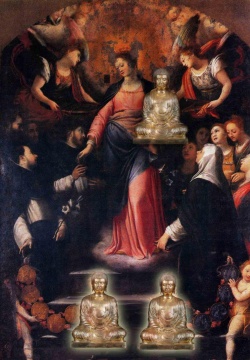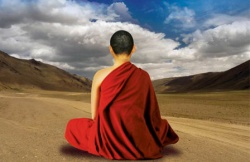100 Dharmas – Introduction
I’ve decided to do a series of posts based around Vasubandhu’s very short Mahayana Treatise Elucidating the Gates of the Hundred Dharmas. This is one of the important Yogacara texts translated into Chinese, which provides a list of a hundred dharmas that collectively make up our mental (and thereby physical) experience (a commentary mentions that this is a short version of a list of 660 dharmas given in the Yogācārabhūmi-śāstra). My idea was to just do one dharma at a time; we’ll see how that goes!
I will be basing my posts mainly on Xuanzang’s translation of the treatise (T. no. 1614) and his disciple Kuiji’s commentary (T. no. 1836).
There is a great translation of the hundred dharmas themselves here by Dan Lusthaus (and anyone seriously interested in Yogacara should take a look at his book Buddhist Phenomenology), and a lot more great information on Yogacara can be found at the website of the Yogacara Buddhism Research Association, which is run by Lusthaus and Charles Muller, another great scholar of Yogacara who specializes in Korean Buddhism.
In this first post, I’ll just present the introduction to the text and the basic categories:
As the World-Honored One has said, “All dharmas are without self.” What is meant by “all dharmas?” What is meant by “without self?” All dharmas can be basically grouped into five categories:
1.) Mind dharmas;
2.) Mental factors dharmas held within the mind;
3.) Form dharmas;
4.) dharmas that do not correspond with the mind;
5.) unconditioned dharmas.
[The first] are supreme among all; [the second] correspond with the first; [the third] are the reflections cast by the first two; [[[the fourth]]] occupies a separate position from the first three; [the fifth] are made manifest by the other four – thus is their sequence established.
T. no. 1614, 31:855b15-20
And here is Kuiji’s commentary on this first part:
Speaking of the eight types of mind dharmas, from the creation of positive and negative karma, to cycling through rebirths along the five destinies, all the way up to the attainment of Buddhahood – all that is done by the mind. Among conditioned dharmas, these are the most supreme, therefore they are mentioned first. As for “corresponding with the first,” this means that these mental factors always correspond with the ‘mind-king’ [i.e., the dharmas that constitute ‘mind’ – the first category]. With respect to the ‘mind-king,’ they are inferior; thus the superior is mentioned before the inferior. As for “reflections cast,” this refers to the previously mentioned dharmas of form. This means that form dharmas do not arise of themselves; they must depend on the previous two mind and mental factors in order to become manifest.
Although the self-authenticating [aspect of cognition may generate cognitive representations of forms through] transformation, it is incapable itself of taking them as its direct object. Therefore, it sets up reflections and speech. Looking at the seeing aspect of consciousness, it is also [generated through the] transformations of the self-authenticating aspect; thus, it is not the same as that reflection. [This seeing aspect] may combine with the [transformations of the] self-authenticating aspect to form the base substance [from which conscious constructions are generated]. It also may discern the dharmas of [imperceptible] forms that arise due to receipt [of the precepts, etc.], which are not reflections generated by consciousness.
When the sixth consciousness perceives these, it takes them as the base substance, and that substance is apprehended through its reflection. The first two [i.e. mind dharmas and mental factors are the subjective conditions or, that which is capable of taking an object and these form dharmas are the objective condition or, that which is taken as an object. First comes the subjective, then the objective; thus, they are arranged in order. As for “separate position,” this refers to those factors that do not correspond [with mind. They are not capable of arising of themselves. Their position is said to be separate with respect to the first three; if we said that the first three are real, then this one would be false, so it is explained fourth. When we speak of “made manifest,”this refers to the fifth class of unconditioned dharmas, of which there are six types.
The nature of these unconditioned dharmas is said to be extremely deep; if they could not be explained in terms of their phenomenal appearances, there would be no way to reveal them. They are made manifest due to the cessation of defilement and attainment of purification in the previous four. The first four are conditioned, and this one is unconditioned; conditioned comes before unconditioned, so this class is explained last.
T44, no. 1836, p. 47, b6-22
I have to admit, I’m still a bit tentative on parts of this translation, particularly the explanation given for the third class of dharmas (form dharmas). At issue here for Kuiji are the subtle mechanisms of consciousness, which according to Yogacara theory both generates and perceives cognitive constructions. A brief explanation may be in order: Yogacara has many ways of dividing up consciousness (or experience – in Yogacara, these are basically the same thing, since all of our experience is mediated through our consciousnesses). One of these schemes consists of four parts: the seen aspect (a thing), the seeing aspect (the automatic operation of consciousness), the self-authenticating aspect (“Hey, I’m seeing a thing”), and the authenticating-self-authenticating aspect (“Yeah, I just saw that thing”).
Sometimes the 3rd and 4th aspects are combined into one. In his Zongjing lu, the Chan monk Yongming Yanshou gives several analogies to describe these 3 or 4 parts of consciousness. In one part, he likens them to a mirror. The mirror itself is the self-authenticating aspect; its ability to reflect is the seeing aspect, the reflection that appears therein is the seen aspect, and the authenticating-self-authenticating aspect is like the handle on the back of the mirror. Anyway, so each of the 8 consciousnesses possesses these 4 aspects, but it is primarily in the 8th consciousness that all of these functions are integrated. For further explanation, we’ll turn to the Ming dynasty monk Mingyu’s 明昱 “superfluous comments” 贅言 on Kuiji’s explanation of the Treatise on the Hundred Dharmas:
When it is said that “although the self-authenticating [aspect of cognition may generate cognitive representations of forms through] transformation, it is incapable itself of taking them as its direct object,” this explains that it is the seeing aspect of the 8th consciousness itself that takes forms as its direct object. The 8th consciousness’s seeing aspect can take the sense-faculties, the body, etc., as objects; this is “direct contact.”
It is also not the case that the seeing aspect of each of the transforming consciousnesses i.e., the first 7 takes forms as their objects. Rather, the self-authenticating aspects of each of these transforming consciousnesses takes the seen aspect generated through the transformations of the 8th consciousness as the base substance on which they each generate a seen aspect; it is these seen aspects which they come into direct contact with.
(CBETA, X48, no. 804, p. 332, a17-b8 // Z 1:76, p. 449, d17-p. 450, a14 //
R76, p. 898, b17-p. 899, a14)
Hopefully this will become clearer as we move through more of the hundred dharmas and get a better look at what exactly these dharmas are.



